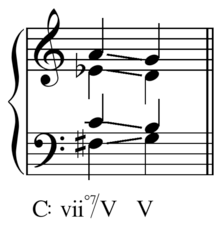Secondary leading-tone chord



In music theory, a secondary leading-tone chord or secondary diminished seventh, as in seventh scale degree[3] or leading-tone, is a secondary chord but rather than being a dominant it is a leading-tone seventh chord or triad, which are similar in function to dominant chords. Also similar to secondary dominant chords they are altered chords.[1] In contrast to secondary dominant chords they do not move in circle progressions but rather resolve up by half step.[4] Fully diminished seventh chords are more common than half-diminished seventh chords[1] and one may also find diminished triads [without sevenths].[3]
Secondary leading-tone chords may resolve to either a major or minor diatonic triad:[1][4]
- In major keys: ii, iii, IV, V, vi
- In minor keys: III, iv, V, VI
For example viiø7/V or viio7/iv. Especially in four-part writing, the seventh should resolve downwards by step and if possible the lower tritone should resolve appropriately, inwards if a diminished fifth and outwards if an augmented fourth.[5]
In harmonic analysis secondary sevenths are expressed in the following format:
where x = the correct inversion symbol [figured bass], and y = the root of the chord of resolution as a Roman numeral.[3]
Sources
- 1 2 3 4 Benward & Saker (2003). Music: In Theory and Practice, Vol. I, p.270. ISBN 978-0-07-294262-0.
- 1 2 3 Richard Lawn, Jeffrey L. Hellmer (1996). Jazz: Theory and Practice, p.97-98. ISBN 978-0-88284-722-1.
- 1 2 3 Blatter, Alfred (2007). Revisiting Music Theory: A Guide to the Practice, p.132. ISBN 0-415-97440-2.
- 1 2 Benward & Saker (2003), p.271
- ↑ Benward & Saker (2003), p.272
